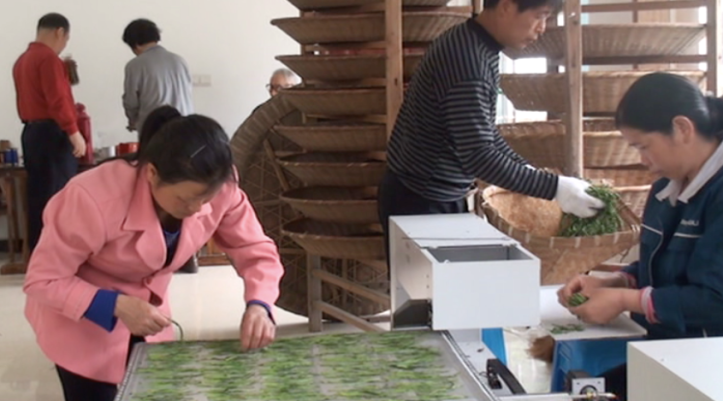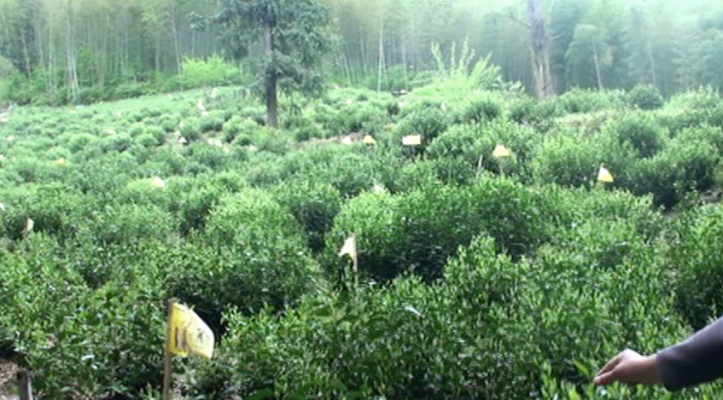“There are no cabs here” said the driver “You will have to walk back when you leave.”
“Why would I leave?” I asked gapping at the beautiful river that ran along side our mountain road, winding into the mountains, shinning in the morning sun. “I have clearly died and gone to heaven”

So there I was, in the mountains of Taiping greeted by the sounds of birds and the sweet smell of tea production. I was in a village called Hou Kong, famous for a green tea called Hou Kui.
There is an peaceful beauty to tea villages. The houses while a roomy size, are very simple in design and in interior furnishing. (In qimen I joked with my travel buddy that they had made these large houses but didnt know what to do with all the space.) Within Each row of houses are stair that lead to the next row. There are canals built within these rows of houses that carry a small stream of water through the village with the occasional slab of concrete acting as a bridge.

I met my first farmers and they showed me their harvest of Hou Kui made the day before. Hou Kui has a signature long flat shape. The farmer told me that they wait 10 days after the initial budding to pick it, allowing the leaf to grow to about 7cm.
Besides my love for Hou Kui, I came to investigate the connection between Hou Kui and Bu Jian. I have always felt that these are two different teas completely, but it seems the general idea in the west is that Bu Jian is just a lower, machine made version of it. Part of the reason for coming to Hou Keng is to get the answer from the source. “Is Bu Jian similar to Hou Kui?” I asked the farmer. He scoffed “Hou Kui is the king of all teas!” He exclaimed. I tried to ask more about it, but he would have no part in talking anymore about Bu Jian. The question asked to a later farmer initialed an eye roll. The comparison between Hou Kui and Bu Jian seems to be blasphemy in the tea region.
This farmer showed me his normal Hou Kui and his wild. I had never heard of wild Hou Kui before. The leaves were a lot shorter, but also wider, they lacked the skinniness of a normal Hou Kui leaf. When I talked about it with West China Tea Company’s So Han Fan, he explained that they were two different varietals which would explain the difference in shape. The flavor held some of its Hou Kui pea and chestnut notes, but was a lot stronger in the savoriness then normal Hou Kui. It was truly a unique tea.

I finished with the farmer and stepped out back to the main road. I passed a room where people were making tea and I dipped into to film some. I saw all the steps I knew of Hou Kui. They pan fried the fresh leaves to kill the green, then put it through the shape making step giving it its famous shape, put it under a roller to make the shape more solid (giving it the signature fabric pattern in the process), then baked it all the way dry. What interested me about this production room though was the shape making step. This usually done by hand, but this time it was done by machine. One lady sat on one side of the machine taking the freshly woked leaves and picking off the extra leaves and stems before placing it in a small machine. The machine then took the leaf, folded it over and pushed out the new leaf onto the baking tray. Another woman sat on the other end making sure the leaves were all lined up and then took the tray to the baker when it was full. This was very interesting to me and I imagined since this step is purely visual ascetic, making it mechanized would not affect the flavor.

I thanked the workers for letting me film then made my way down the road. I didn’t really have a plan. I had some Hou Kui and could hypothetically go back successful, but I was in this beautiful mountain village and decided to look around more.
I ended up meeting another farming family who showed me their fields. We walked through the open fields of the rest of village, to the very edge where tea fields met the bamboo forrest and then walked some more. We came upon his field which was in the thick of the bamboo. He said the bamboo gave the tea a fragrance. He showed me his sticky pads which he used to catch bugs instead of spraying the fields with pesticides.

All in all I spent two days in Hou Keng. I ate meals with the family, and went deeper into the mountains to the more sought after fields. Unfortunately my hosts in Hou Keng did not seem to interest in using the translating app, so I was not able to get a lot of solid information. The good news is that they invited me back next year where I will spend more time and with better Chinese language skills, be able to understand a lot more.
Traditionally Hou Kui is folded by hand. This process is actually very recent and marks the rise in popularity for Hou Kui. This painstaking process is part of the reason Hou Kui is so expensive.
[…] I learned is the diversity of micro locations with in famous tea locations. I touched on this in my Hou Kui article, but I want to expand on it a […]
LikeLike
[…] shops, Tunxi, where I am living, is very close to Huang Shan and close to three major tea regions. (Taiping Hou Kui, Huangshan Mao Feng and Qimen red). I knew if I looked around enough I could find something […]
LikeLike